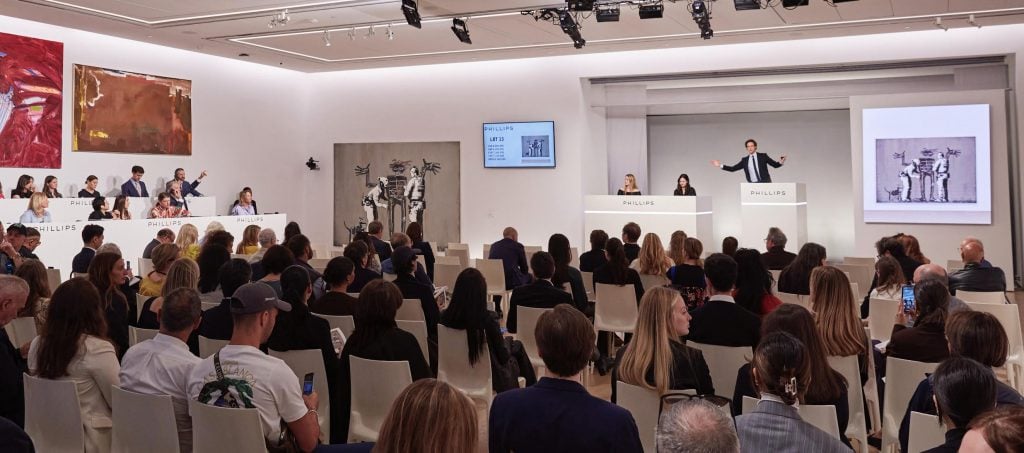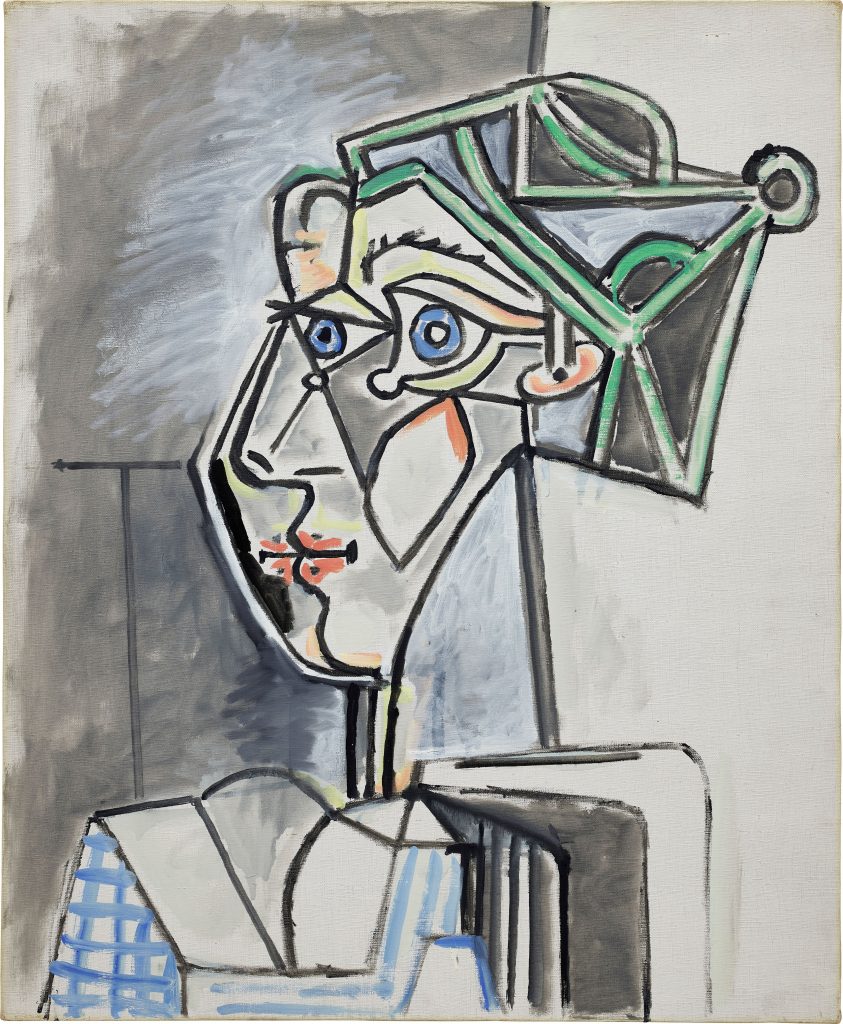Auctions
Phillips 20th Century and Contemporary Art Evening Sale Netted $70 Million, Driven Largely by Two Type-A Bidders on a Mission
The sale was led by a Banksy piece, which has its original iteration at the Barbican and sold for $9.7 million.

The sale was led by a Banksy piece, which has its original iteration at the Barbican and sold for $9.7 million.

Annie Armstrong

Phillips’s contemporary art evening auction put on a diverting show Wednesday night, if only because of two swashbuckling phone bidders who swept into the sales room and made off with many of the evening’s most impressive lots. All told, the night’s offerings garnered a decent 89 percent sell-through rate, netting a healthy $70 million on a pre-sale estimate of $60 million to $85 million via a slow but steady sale shored up by a few lots that emerged as runaway successes. Perhaps due to a chill in the air, however, a handful of lots by Javier Calleja, Lisa Yuskavage, Robert Motherwell, and Mickalene Thomas were withdrawn at the beginning of the sale (these were not accounted for in the sell-through rate), and pieces by Robert Colescott, Ed Ruscha, Joan Miró, and Issy Wood failed to find buyers on the floor.
But back to those swashbucklers. Sprinting out of the gate, Phillips led off the evening with an untitled painting by Noah Davis—a gestural painting of a woman collapsed in sleep, completed in 2010—that ignited a 12-minute bidding war before selling to an anonymous phone bidder for $991,000, nearly ten times its estimate of $100,000 to $150,000. The same bidder snapped up another hotly contested painting later in the sale: Henry Taylor’s portrait of a security guard, titled Dakar, Senegal #3 (2019), that had its modest estimate of $80,000 to $120,000 smashed—to applause from the audience—when it sold for a cool $584,000.
The other prime mover of the evening was the phone bidder glued to the ear of Phillips specialist Jean-Paul Engelen, who made a splash early in the sale by securing the two textile-based canvases by Yayoi Kusama, Red Stripes and Blue Spots, both of which were made in 1965 and bought by collectors Agnes and Frits Becht in the same year. (Agnes Becht famously said of their Yayoi Kusama collection, of which they had enough to fill a shipping container to the brim, “It was so beautiful, I think I must have died from it.”) The works never left the couple’s collection until now, and Engelen’s bidder bought them for $2.7 million and $3.2 million respectively, overshooting their shared low estimate of $2.5 million. The pieces will be displayed in a retrospective of the artist’s work at Amsterdam’s Stedelijk Museum that opens this fall.
The same bidder also snatched up the most expensive work of the night, a Banksy in which two police officers and a police dog stop and frisk a Basquiat-esque figure. Titled Banksquiat. Boy and Dog in Stop and Search, the piece is a second iteration of the original in situ work that remains at the Barbican in London, and it sold to Engelen’s client for $9.7 million, just below the middle of its $8 million to $12 million estimate.

Pablo Picasso, Tête de femme au chignon (1952). Courtesy of Phillips.
Among the other high-caliber and high-price works that went to sundry bidders over the evening were Pablo Picasso’s Tête de femme au chignon (1952), which emerged as second-most-expensive work of the auction when it sold for $7.3 million on a $6 million to $9 million estimate; Roy Lichtenstein’s Girl in Mirror (1964), which sold for $5.5 million against an estimate of $4.5 million to $5.5 million; and Mark Grotjahn’s Untitled (Standard Lotus XVI Face 44.15) (2013), which raked in $4.3 million on its $3.5 million to $4.5 million estimate.
While some pricey sales were made, discount-hunters had their time in the sun as well. Perhaps most visibly, Joan Miró’s L’espace (1937) went for $381,000 on an estimate of $800,000 to $1.2 million. Removing fees, only five lots hammered above their low estimate on the auction floor out of 37 total lots.
One more interesting statistic? Of the artworks offered Wednesday evening, an impressive 80 percent had never been brought to auction before. Robert Manley, the house’s deputy chairman, and Engelman wrote in a joint statement: “This approach is something that is distinctly Phillips’s own, and we are grateful for the hard work of our international team in building an auction that so brilliantly captures the breadth of the category.”